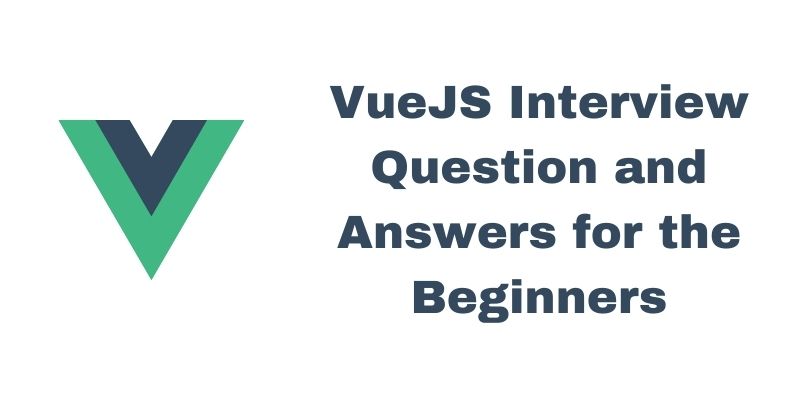VueJS is a progressive JavaScript-based framework which has been develop to build interactive user web interfaces. It is mainly focusing on the View Part or you can say as the front end. VueJS is very easy to integrate with other libraries and projects. It is easily understandable for beginners and the installation of Vue JS is fairly simple.
VueJs tutorial has two different parts where VueJs tutorial for beginners and advance concepts has been included. As VueJS is simple to install and use, so it is getting popular day by day. Even beginners can start building their own user interfaces very easily. , so it is getting popular day by day. Even beginners can start building their own user interfaces very easily.
Here we are presenting some top Vue JS Interview Questions and Answers that will help you to learn about VueJS and make you prepare for the Interview rounds.
1. What is VueJS?
Ans: VueJS is an open-source progressive JavaScript framework which is use to develop interactive web interfaces and single-page application (SPAs). VueJS is mainly responsible for View Layer only. It is commonly known as Vue and pronounce as View.Js or View. VueJS is mainly responsible for View Layer only. It is commonly known as Vue and pronounce as View.Js or View.
2. Why VueJS is termed a progressive framework?
Ans: VueJS is called as a progressive framework as it can be changed as well as develop continuously.
3. What are the benefits of using VueJs as compared to other front end frameworks?
Ans: VueJs has several types of benefits as mentioned below:
- Small Size: For the majority of the JavaScript Framework, achievement depends on the size of the framewrk and VueJs has a very small size which is almost around 18 to 22 KB that can be download easily.
- Easy to Integrate: As it is a JavaScript-based framework, so it can be easily integrate with other applications and provides components for everything.
- Easily Understandable: VueJs is a simple structure and can be use in both smaller as well as larger projects in an easy way.
- Documentation: Easy Documentation is available in VueJS.
- Flexibility: VueJs provides different options of writing templates in HTML files, JavaScript files as well as in pure JavaScript files also by using Virtual nodes so that the concept can make everything easier for the developers of Angular, React and other JavaScript backgrounds.
- Brilliant Tools: VueJs comes up with brilliant tooling like CLI which can easily create the initial application setup.
- Two-way Communication: VueJS also supports partially MVVM architecture and also offers two-way binding concepts which are similar to AngularJS that speeds up HTML blocks.
- Documentation: Easy Documentation is available in VueJS.
- Small Size: For the majority of the JavaScript Framework, achievement depends on the size of the framewrk and VueJs has a very small size which is almost around 18 to 22 KB that can be download easily.
4. What do you mean by Directives in Vue.JS?
Ans: Directive is basically a special code in the markup which built the library to carry out its activities with that DOM element. VUEJs already have some in-built directives like v-model, v-bind etc. VUEJs already have some in-built directives like v-model, v-bind etc. You can create custom directives with this as well. VUEJs already have some in-built directives like v-model, v-bind etc. You can create custom directives with this as well.
Vue.Js mainly uses double braces {{ }} as placeholders for data. VueJs Directives are HTML attributes with the prefix v-.
Read Also: – What is Microsoft Word: A Complete Guide 2022
5. Describe the one-way and two-way data binding in Vue.Js.
Ans: Vue.Js supports both one-way and two-way data binding options –
- One way Binding: It is the basic form of data binding were you can update classes, styles from JavaScript properties as mentioned below:
<span v-bind : class= “{ active : isActive }” ></span> - Two-Way Binding: It updates HTML view and their related JavaScript properties as mentioned below:
<input v-model=”message” placeholder =”edit me”><span>Message is: {{ message}}</span>
The v-model directive binds the value of HTML elements to application data.
6. Create an instance in Vue.JS?
Ans: it is partly subjective by the MVVM pattern which is the main cause its illustration is sometimes referred to as VM. it is partly subjective by the MVVM pattern which is the main cause its illustration is sometimes referred to as VM. You can execute the Vue.Js application by creating its instance as mentioned below:
var vm = new Vue({
//options
})
7. What do you mean by filters in VueJS?
Ans: Vue.Js filters are mainly utilized to transform the output that is going to render on the browser. Vue.Js filters are mainly utilized to transform the output that is going to render on the browser. Vue.Js filter is basically a function to take the value, after that process it and then again return the processed value to its destination. In the Markup form, it is denote by single pipe (I) and can be easily follow by one or more arguments:
<element directive = expressions | filterId [args…]></element>
8. What is Vue Js mixins?
Ans: Mixin is a flexible way that can be reuse in the functionalities or code to the Vue instances as well as components. Mixins can be written in a separate file and can be share among the components over and over again. Mixins can be written in a separate file and can be share among the components over and over again.
9. Explain Reactivity in VueJs?
Ans: When you make any changes on the data value then it activates page update to reflect data changes. Vue computed property, data property all are reactive.
10. What is the component prop in Vue JS?
Ans: Component Prop is mainly used to pass the data from parent to child component. A component can old as many as a prop. It is a custom attribute and while any value passed to this attribute, it will become property on that component instance. It is a custom attribute and while any value passed to this attribute, it will become property on that component instance.
Above are the top 10 Interview Questions for Vue JS that will provide basic knowledge in Vue Js as well.





More Stories
Benefits of Blogging in Education
4 Ways to Make Science Learning More Interesting
What are the best books to prepare for the UP Polytechnic Lecturer exam